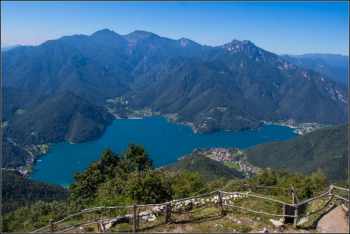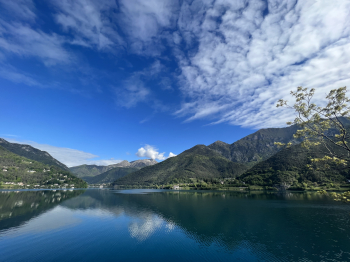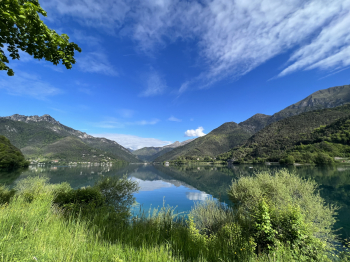Valle di Ledro
On 28 June 2008, a Partnership Agreement was signed between the Association of Valle di Ledro Municipalities on the one hand and eight Czech towns and municipalities (Příbram, Všeň, Milín, Buštěhrad, Nový Knín, Ptice, Chyňava, Doksy) on the other.
The municipality of Ledro was created by the merger of the former municipalities Tiarno di Sopra, Tiarno di Sotto, Bezzecca, Concei, Pieve di Ledro and Molina di Ledro, which formed the Union of Municipalities of the Valle di Ledro. The municipality is located in the province of Trentino, 40 km southwest of Trident. It has more than 5 thousand inhabitants.
History, tourism, sport and Czech footprint
Valle di Ledro is located in northern Italy in the southwestern part of the province of Trentino on the border with Lombardy. It is less than 60 kilometres from Trento, the capital of the province of Trentino, which is famous for the Council of Trent in the 16th century. Valle di Ledro is easily accessible by car or by train (Trento and Rovereto railway stations) and bus.
Valle di Ledro lies in a valley between Lakes Garda (the largest lake in Italy) and Idro. It has a rich history behind it. In 1927, the remains of houses on stilts were discovered in the eastern part of Lake Garda, proving that man inhabited the area more than 5,000 years ago. The remains of the dwellings contained many treasures - jewellery (some made from Baltic amber) and everyday objects, which are now housed in the local museum and are listed as UNESCO World Heritage Sites.
The Valle di Ledro is characterised by a specific climate, ranging from alpine to Mediterranean, thanks to its location, which ranges from an altitude of 60 metres to more than 2,000 metres above sea level. The local fauna and flora are also very specific. The Tremalzo Pass, for example, is famous for the migration of migratory birds from Central Europe. There is a bird ringing centre organised by the local museum, which studies bird migration. In recent years, the pass has also become one of the main tourist attractions, thanks to the spectacular views stretching from Lake Garda across the Apennines to the high Alpine peaks of western Trentino.
The Ledro Valley is becoming a popular tourist destination, attracting tourists from all over Italy and Europe, who are increasingly choosing the Ledro Valley as their holiday destination. It is no coincidence that Valle di Ledro is one of the top ten most visited tourist holiday destinations in the Trentino region. Tourism in the Ledra Valley is suitable for active holidays, which include various outdoor activities, as well as for relaxing holidays. A great advantage is the lake, which is the centre of many sporting activities such as swimming, sailing, canoeing or paddleboarding. Many of the locals and tourists take up running and cycling. Adrenaline experiences such as paragliding and canyoning are also popular. Valle di Ledro often hosts major sporting events such as the Italian Canoe Championships, Ledro Skyrace, Ledro Running or Ledro Trentino Trail. One of the prominent figures on the local sports scene is cross-country skier Federico Pellegrino (World Champion and silver medallist at the 2018 Olympics in cross-country skiing) and middle-distance runner Yeman Crippa.
Also worth a visit is the Valle di Concei, where you will find a small theme park, particularly popular with families with children. Here you can admire dozens of wooden sculptures made by local artists from the LederLegn association, which are freely scattered around the park. They are all inspired by the legend of the fairy Gavardina.
Another offer for an intense cultural experience is Ledro Land Art, an art park located in the Pur forest area, where you can see dozens of works of art made from natural materials. Two to three new works are added every year. The two churches of Tiarno di Sopra and Tiarno di Sotto, famous for their rare 16th-century frescoes and paintings and the altarpiece by Tintoretto, are also not to be missed. The bell tower in Tiarno di Sotto is one of the tallest in Italy.
Tourists are attracted by the local restaurants, which offer Italian cuisine as well as some Czech and Moravian dishes. The ancestors of the current inhabitants of the valley brought the recipes from Bohemia, where they were forced to move during the First World War to avoid the approaching front. You can taste bread dumplings, potato polenta and many others.
During the First World War, the Valle di Ledro was part of South Tyrol, which was then part of Austria-Hungary. As soon as Italy entered the war in May 1915, the Valle di Ledro became the southern Austro-Hungarian line of defence, and the Austrian military commanders decided to evacuate the entire civilian population, which was then moved to the interior of the empire, including Bohemia and Moravia. The civilian population, mostly women, the elderly and children, was divided into groups which were assigned to individual municipalities. A year earlier, in 1914, men between the ages of 16 and 50 were conscripted, enlisted in the Austro-Hungarian army and sent mainly to the eastern front in Halychyna to fight against the Russian army.
After initial difficulties caused mainly by the difference in language and the two cultures, and also by the difficult situation in which the inhabitants of the selected Czech and Moravian towns and villages themselves lived, the Ledren families gradually began to integrate into the Czech ones. When the moment of parting came after four years of living together, many tears were shed. As a reminder of those sad years and in order to re-establish contact with Czech friends, a partnership agreement was drawn up in 2008 in Valle di Ledro between six municipalities from Valle di Ledro and eight Czech municipalities chosen from among the many that had hosted Ledra refugees during the First World War. The municipalities are Buštěhrad, Chyňava, Doksy, Milín, Nový Knín, Příbram, Ptice and Všeň. Especially in the district of Příbram there were many large groups of refugees from Ledren, a total of 683 persons divided into families in Příbram, Březové Hory, Milín, Nový Knín and other surrounding villages. In 2009, a bronze and granite monument was unveiled in the Basilica on Svatá Hora, in the presence of the mayors of the partner towns and about 500 Ledren residents and more than a thousand Czech friends, in memory of the more than 400 Ledren residents who are resting in Czech and Moravian cemeteries. Since then, the partner municipalities have taken great initiatives, especially in the fields of culture and education. In the Valle di Ledro, one of the streets near the lake in Pieve was named after the town of Příbram.
A shared history

In 2018 we commemorated the 100th anniversary of the return of war refugees to their homeland. The time that has passed in the meantime is long, after all, and this common story of ours could easily be forgotten. We would like it to live on. That is why in 2018 the town, with the help of Věra Smolová and the staff of the Jan Drda Library, prepared a literary and artistic competition for pupils of Pribram primary and secondary schools. The children could learn about the events that their town lived through a hundred years ago and empathise with the fate of Italian children. They expressed their impressions in stories and drawings, which were printed in the book Memoria Viva - Living Memories. The collection was then donated to the inhabitants of Valle di Ledro, who visited Příbram in April 2018.
The cooperation between the Primary School of 28 October and the school in Valle di Ledro is very lively. Pribram children visited their Italian friends in June 2019, learning about local history and nature and making new friends. Cooperation also takes place between the crib makers from both municipalities, and thanks to this you can admire the cribs from Valle di Ledro on the Holy Mountain at Christmas for the last few years. A part of the new recreation park around the Čekalíkovský Pond, which should be open to the public hopefully in 2021, will also be dedicated to the friendship of our communities.
Details about Valle di Ledro can be found on the vallediledro.com website.
Don't miss
May: Flower Festival in Dromae
August: Night in a Stake House - a competition with a chance to win a sleepover in a Bronze Age man's house
September: St Michael's Day with a parade of cattle from across the valley
December: a Christmas market inspired by the figure of Bernard Gilli, a giant who lived in the 18th century, stood 2.6 metres tall and visited many of Europe's royal courts during his lifetime.
How the Ledrens live
The economy of the Valle di Ledro is based mainly on tourism, with significant links to agriculture, handicrafts, small-scale industry, trade and services. The whole area is governed by a joint local authority, which was created ten years ago by the merger of six municipalities: Bezzecca, Concei, Molina di Ledro, Pieve di Ledro, Tiarno di Sopra and Tiarno di Sotto. The current mayor is Renato Girardi, who has recently been re-elected. Valle di Ledro has approximately 5 600 inhabitants.
The municipality has a kindergarten (for children up to 6 years old), a primary school (6-11 years old) and a primary school (11-14 years old). Students attending secondary schools (technical or grammar schools) commute to the town of Riva del Garda, which is 15 km away. There are universities in Trento (54 km), Verona, Padua, Venice, Bologna, Parma, Brescia and Milan.













